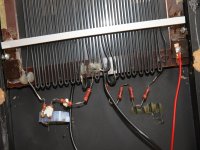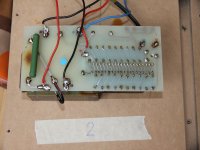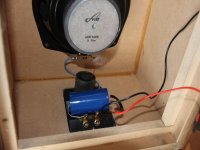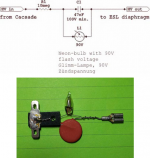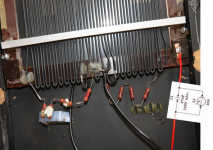Recently I bought a pair of audiostatic ESH100 to rebuild it completely. It's an hybrid electrostatic with a subwoofer in the base. I have no idea what to expect of this speaker in terms of sound quality. But because I just finished the repair of my Quad 2805 speakers (at least I hope so) and have a lot of stuff left in the esl repair kit that I bought from Australian based ErAudio I decided to buy a pair of worn out ESH100's.
While taking the speakers apart I noticed that there has been worked on before. The foils were in bad condition so I have to renew them. I have a few questions.
In the first picture you can see the resistors of the stator segmentation. Are these the correct resistors ? I have read that some people use a different segmentation. Is this recommended ?
In the second picture - the high voltage pcb - there is a fat green resistor that has a burn mark underneath. What is the cause of the overheating of this resistor ? Playing too loud?
In the third image a picture of the crossover. You can see a fat capacitor and a coil. The capacitor doesn't seem original to me. Could it be a (useful ??) mod.
In one of the threads I have read about incorporating a neon in the hv circuit to check for voltage leakage. Can someone tell me how ?
While taking the speakers apart I noticed that there has been worked on before. The foils were in bad condition so I have to renew them. I have a few questions.
In the first picture you can see the resistors of the stator segmentation. Are these the correct resistors ? I have read that some people use a different segmentation. Is this recommended ?
In the second picture - the high voltage pcb - there is a fat green resistor that has a burn mark underneath. What is the cause of the overheating of this resistor ? Playing too loud?
In the third image a picture of the crossover. You can see a fat capacitor and a coil. The capacitor doesn't seem original to me. Could it be a (useful ??) mod.
In one of the threads I have read about incorporating a neon in the hv circuit to check for voltage leakage. Can someone tell me how ?
Attachments
#1. The resistors on the wires are ok. Only the 2-4 wires in the center get all frequencies. The resistors do filter out heigh freqs. This is because the amp will not get burned by 0 ohm.... Kortsluiting....
I did describe a lot of my rebuilded es100 on my facebook. You want to get that?
I did describe a lot of my rebuilded es100 on my facebook. You want to get that?
…I have read about incorporating a neon in the hv circuit to check for voltage leakage. Can someone tell me how ?
The neon bulb leakage indicator circuit is made up of a neon bulb in parallel with a 0.047uF capacitor.
It is placed in line between the output of the HV supply and the diaphragm.
In your case, you could cut the red wire leading to the diaphragm contact and insert the circuit there.
Alternatively, it could be inserted where the red wire connects to the HV board if that location is easier to work with.
Attachments
Afaik, at the moment the neon bulb flashes the power supply is connected to the diaphragm.
Then in a fraction of a second the diaphragm is charged. Therefore a high flash rate is an indication of unwanted charge losses in other words: possible hv leakage !
I’m sure more knowledgable members have a more complete answer.
Then in a fraction of a second the diaphragm is charged. Therefore a high flash rate is an indication of unwanted charge losses in other words: possible hv leakage !
I’m sure more knowledgable members have a more complete answer.
When I glued the membrane of my Quad 2805 I used polyurethane glue as included in the repair kit of ErAudio.
Now for this Audiostatic this seems less practical to me with regard to the length of the stators. When searching the net I see a lot of people use double sided tape for this job.
I would like to get an opinion on this matter. Tape or still (liquid) glue ? And which tape or glue did you tried successfully ?
Now for this Audiostatic this seems less practical to me with regard to the length of the stators. When searching the net I see a lot of people use double sided tape for this job.
I would like to get an opinion on this matter. Tape or still (liquid) glue ? And which tape or glue did you tried successfully ?
The polyethylene glue is a sure bet for a solid glue junction that will stay put over time.
With thin DSTape you cannot say it will keep its free air resonance constant unless you have a bolted perimeter
When I rebuilt my Quad panels I did try one with DS tape and noticed a well damped membrane but didn’t trust the longevity since Quad used simple spring clamps in sparse quantity so I switched back to poly
Regards
David
With thin DSTape you cannot say it will keep its free air resonance constant unless you have a bolted perimeter
When I rebuilt my Quad panels I did try one with DS tape and noticed a well damped membrane but didn’t trust the longevity since Quad used simple spring clamps in sparse quantity so I switched back to poly
Regards
David
The polyethylene glue is a sure bet for a solid glue junction that will stay put over time.
With thin DSTape you cannot say it will keep its free air resonance constant unless you have a bolted perimeter
When I rebuilt my Quad panels I did try one with DS tape and noticed a well damped membrane but didn’t trust the longevity since Quad used simple spring clamps in sparse quantity so I switched back to poly
Regards
David
I've played with 3M VHB adhesive transfer tape on quad panels, and it sticks very well to the mylar diaphragm, but is a mixed bag on the plastic stator frame. I continue to use a 2-part epoxy for holding the diaphragms in place. it's hard to beat a two part epoxy for shear resistance.
Sheldon
When I glued the membrane of my Quad 2805 I used polyurethane glue as included in the repair kit of ErAudio.
Now for this Audiostatic this seems less practical to me with regard to the length of the stators. When searching the net I see a lot of people use double sided tape for this job.
I would like to get an opinion on this matter. Tape or still (liquid) glue ? And which tape or glue did you tried successfully ?
I fixed a set of ES50's many years ago, and I used a two part epoxy. I am familiar with the process so I use an adhesive that sets in minutes, but you may want a bit more working time so you can relax and apply and position without the time pressure.
Sheldon
Compared to the Quad diaphragm the foil tension of the Audiostatic is relatively low and - well - I’m in for an experiment. One diaphragm will be glued with polyurethane glue. The other one with 3M 9088 tape. According to 3M “The adhesive system used on these products provides good adhesion to both high and low surface energy substrates”. Like our foils. And what’s more if something is going wrong the Audiostatic stators are relatively easy to get out of the frame.
@Sheldon, I’ve read somewhere that polyethylene foil doesn’t adhere to epoxy and that it is easy to peel the foil off. Your experience is telling me the opposite and that is interesting.
@Sheldon, I’ve read somewhere that polyethylene foil doesn’t adhere to epoxy and that it is easy to peel the foil off. Your experience is telling me the opposite and that is interesting.
@Sheldon, I’ve read somewhere that polyethylene foil doesn’t adhere to epoxy and that it is easy to peel the foil off. Your experience is telling me the opposite and that is interesting.
That is true, it's not a super rugged bond, but the bond is plenty strong enough for the application in my experience. And I know it won't creep over time. I've been fixing quads for a while and haven't had any issues.
There's lots of good choices for adhesives, my way is likely not the only way or the best way, but it's worked well for me, and my processes and results are really dialed in at this point. Take my experience under advisement but don't follow in my footsteps.
Sheldon
Off topic in my own thread.
Sheldon, a few months ago you gave me advice about a distortion problem in my quad 2805.
You told me that it was probably the clamping circuit that was activated. I discovered a minuscule hole in one of the diaphragms. However I found it difficult to believe that such a mini hole, too small for an ant, could activate the clamp. But I replaced the diaphragm. Now after having used the esl for several months there is not a trace of distortion anymore. So in the end you were right in your analysis. Thanks again
Sheldon, a few months ago you gave me advice about a distortion problem in my quad 2805.
You told me that it was probably the clamping circuit that was activated. I discovered a minuscule hole in one of the diaphragms. However I found it difficult to believe that such a mini hole, too small for an ant, could activate the clamp. But I replaced the diaphragm. Now after having used the esl for several months there is not a trace of distortion anymore. So in the end you were right in your analysis. Thanks again

Hello clog. My name is edwin olthuis.
I live in the netherlands. I have rebuild a esh 50. And it sounds perfect. I have had a lot of help from bolserst. Thanks again. If you are interested, a have a spare set of woofers for you and two coils of 4.7 milli henry with a very low internal resistance. It makes the output sound of the woofers a bit tighter.
Let me know if you are interested.
I live in the netherlands. I have rebuild a esh 50. And it sounds perfect. I have had a lot of help from bolserst. Thanks again. If you are interested, a have a spare set of woofers for you and two coils of 4.7 milli henry with a very low internal resistance. It makes the output sound of the woofers a bit tighter.
Let me know if you are interested.
Thank you Edwin. Right now I’m in the process of glueing the diaphragm (third try !!). I still have to test the woofers so I don’t know if I need to replace one of them, but your offer could be interesting. I’v read your refurbishing threads. Very interesting. Btw what foil adhesive do you use ??
- Status
- This old topic is closed. If you want to reopen this topic, contact a moderator using the "Report Post" button.
- Home
- Loudspeakers
- Planars & Exotics
- The rebuild of an old Audiostatic ESH100
